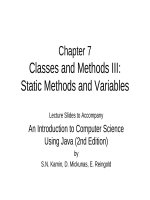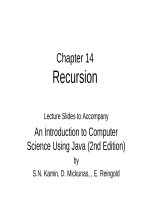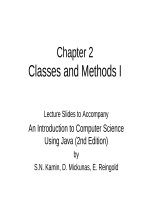Lecture An introduction to collective bargaining and industrial relations (4e) – Chapter 6: Union strategies and structures for representing workers
Bạn đang xem bản rút gọn của tài liệu. Xem và tải ngay bản đầy đủ của tài liệu tại đây (459.61 KB, 38 trang )
Chapter
6
Union Strategies and
Structures for Representing
Workers
McGrawHill/Irwin
An Introduction to Collective Bargaining & Industrial Relations, 4e
Copyright © 2008 The McGrawHill Companies, Inc. All rights reserved.
1 3
6 3
Unions and Politics
U.S. labor unions have historically devoted the bulk of
their efforts to collective bargaining as opposed to
political action
This is consistent with the concept of “business
unionism”
There is no sizable labor party in the U.S., as is the
case in a number of European countries
Unions have not typically identified themselves with a
socialist political platform, as is another characteristic
of many European labor unions
1 4
6 4
American Unions Do Have a Political
Agenda
• Unions have been ardent and successful supporters of
federal legislation to protect and improve employment
conditions, including:
Minimum wage, OSHA, the DavisBacon procedures,
Family and Medical Leave Act, and various pension
regulations
Unions mobilize voters, play an active role in state and
local politics, and the preparation of legislation
1 5
Labor’s Voice in National and Corporate
Affairs
6 5
• In recent years the AFLCIO has increased assistance
to candidates for President and Congress who support
its labor, trade, economic, and social policies
• John Sweeney created a new Department of Corporate
Affairs to identify strategies for making corporate
behavior more responsive to worker interests
1 6
6 6
Labor’s Role in Coalition Politics
• In recent years, labor has increased its efforts to build
or join coalitions for changes in legislation or
corporate behavior
• An example would be the “Living Wage”
Labor campaigns have produced community level
ordinances in over fifty U.S. cities requiring
companies that do business with local government to
pay above the minimum wage
1 7
Current Debates in Unions over the
Appropriate Role of Politics
6 7
• Some unionists want to reorient strategy away from
bargaining and toward political action
An independent labor party was created in 1995, but to
date has attracted few members and has limited
political influence
Labor’s role in political affairs likely will take on
greater importance in the future as a builder of
coalition politics
1 8
Union Growth and Membership
Characteristics
• Union Membership Figures: The Loci of Membership
Union membership peaked in the mid1940s at around
35 percent
By 1960, membership had declined to 31 percent of the
nonagricultural labor force
By 2006, membership declined to 12.0 percent
New York and Hawaii had the highest union densities,
with 24.4 percent and 24.7 percent
North and South Carolina had union densities of 3.3
percent
6 8
1 9
6 9
Union membership as a percentage of the
nonagricultural labor force, 19302002
1 10
6 10
By Industrial Sector
• The percentage of manufacturing employees
unionized declined from 42.4 percent in 1953
to 13.0 percent in 2006
However, the percentage of government
employees in labor unions rose over the same
period from 11.6 to 36.2 percent
Unionization in the service sector rose from
9.5% in 1953 to 13.9% in 1975, but fell to
3.1% in 2006
1 11
6 11
By Occupation
• Union membership also varies by occupation
• By 2006:
In bluecollar ranks, the highest levels of unionization
were among craft workers at 15.8%
Semiskilled occupations, such as operators,
fabricators, and laborers were 15.5% unionized
Among whitecollar workers, professional occupations
were the most organized at 17.7%
Whitecollar union membership in the service sector
was 11.4%
1 12
6 12
By Demographic Group
• In 2006, 13.0% of all men and 10.9% of all women
were members of unions
Female membership has been rising
Women made up 39.6% of all union members in
2000
Black workers are more likely to be members of
unions than are whites, with 14.5% unionized
versus 11.7% of all white workers
Hispanics have the lowest union rate at 9.8%
1 13
6 13
Membership in Large Unions
• A majority of members are concentrated in a few
large unions
In 2004, the five largest unions in the country
were the National Education Association
(NEA), the Service Employees International
Union (SEIU), the United Food and
Commercial Workers (UFCW), the American
Federation of State, County, Municipal
Employees (AFSCME), and the International
Brotherhood of Teamsters
Public sector unions were the fastest growing
since 1970
1 14
6 14
Recent Union Membership Declines
• By 2006, union membership had fallen to 12.0% from
a 1945 peak of 35.5%
• Membership declined rapidly after 1977 because most
highly unionized industries were hit the hardest by
recessions, by the declining competitiveness of U.S.
manufactured goods, and by the economic and
organizational restructuring within these industries
Steelworkers lost 511,000 members and the UAW lost
494,000 members from 1979 to 1983
1 15
6 15
The Cyclical Factor
• The Cyclical Factor
John Commons was one of the first to note that union
growth was directly correlated with prosperity
Union membership rose and fell in sync with the
business cycle
Commons posited that workers became more
aggressive in pursuing their goals in good economic
times, while employers became less resistant since
profits were increasing
1 16
6 16
Structural Factors
• Historical and legal Influences
Evidence suggests that cyclical factors are not the only
influences on union growth
Union growth did not rebound after 1992 even with
economic expansion
Social change is a large factor, such as the great
depression and wartime economy
1 17
6 17
The Influence of Laws and Public Policy
• Union growth and decline is also impacted by legal
and public policy
Union membership in righttowork states is another
illustration on how public policy can influence union
growth
Twentytwo states have such laws, where it is illegal
to require employees to join unions as a condition of
employment
Union growth is strong in states granting public
employee unions the right to collective bargaining
1 18
Explanations of Recent Union
Declines
• Structural Changes n the Economy and the Labor
Force
Changes in the nature and location of jobs have hurt
union growth
Jobs moving away from the east and west coasts, and
northcentral regions where unions have been
historically strong
Statistics suggest that 40% of the decline in union
membership in the past 30 years can be explained by
region, industry, and occupational characteristics
6 18
1 19
Union Avoidance through Employer
Election Campaign Practices
• Management has become more sophisticated and
has increased resistance to union organizing
• They now use consultants, direct discussion with
employees, speeches by executives, and in some
cases threats to thwart union organizing
• Management’s resistance to unions during election
campaigns appears to be associated with low union
win rates
6 19
1 20
Employer Substitution through
Personnel Practices
6 20
• Management does not always wait until an organizing
election to try to convince employee that unions are
unnecessary
• Management can adopt sophisticated personnel
practices that substitute for union representation
Avoidance of unionization is the primary objective
of the human resource industrial relations pattern
1 21
6 21
Government Substitution
• Since the late 1960s, government has become more
directly involved in shaping employment conditions
• Governmental influence can come through regulations
on health, safety, minimum wage, pension rights and
funding
Government substitution does not seem to hinder
union growth in Europe
For unique cultural reasons, government
substitution may have a greater negative impact on
U.S. unionization
1 22
6 22
American Worker Ideology
• Some historians argue that American culture and the
absence of aristocratic traditions lead to a weak union
appeal
Seymour Lipset contrasted American and Canadian
ideologies and claimed they explained the higher
union membership in Canada, where unions are
stronger
However, opinion polls show that attitudes toward
unions are similar in the U.S. and Canada, casting
doubt that ideology alone explains the difference;
perhaps management resistance explains the difference
1 23
6 23
Internal Union Affairs and Actions
• Unions may bear some blame for their organizing
difficulties and decline
• Unions have suffered from corruption and slow
adaptation to change
• They have not dedicated sufficient resources to
organizing efforts
• Union organizing only produces a fraction of the
new members needed to offset union members
leaving the labor force
1 24
6 24
Union Structures for Collective Bargaining
• The AFLCIO
A federation of national unions
The major federation in the United States
Promotes the political objectives of unions through
political lobbying and dissemination of information
to union members
• With the election of President John Sweeney in
1995, the AFLCIO increased organizing efforts
Has no formal authority in the bargaining efforts of
its member national unions
1 25
6 25
The Structure of National Unions
• National unions are the center of political power
within most trade unions in the United States
They are actively involved in the negotiation of
collective bargaining agreements
They sanction and provide assistance to their member
local unions









